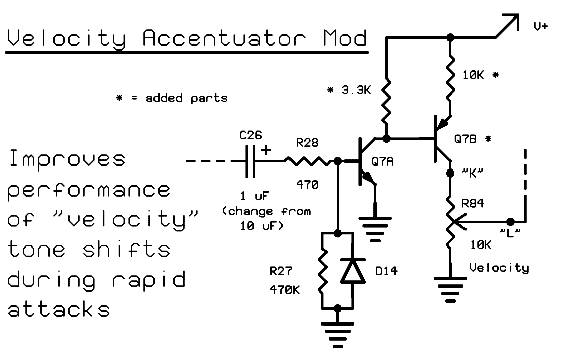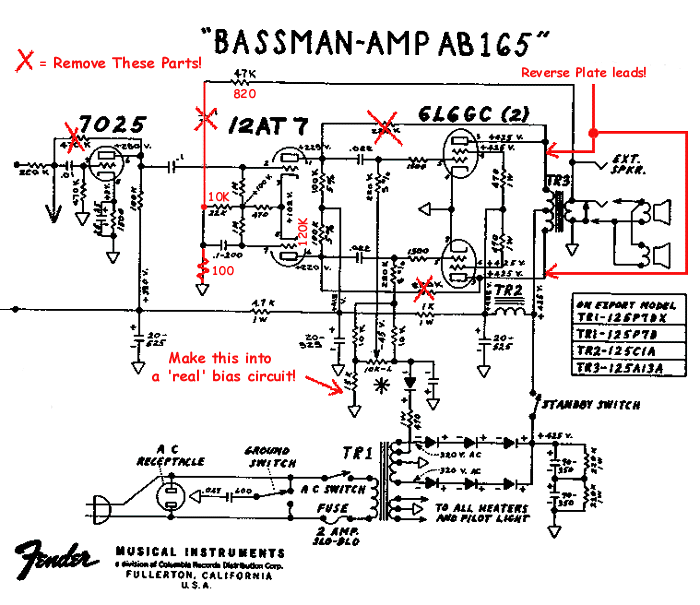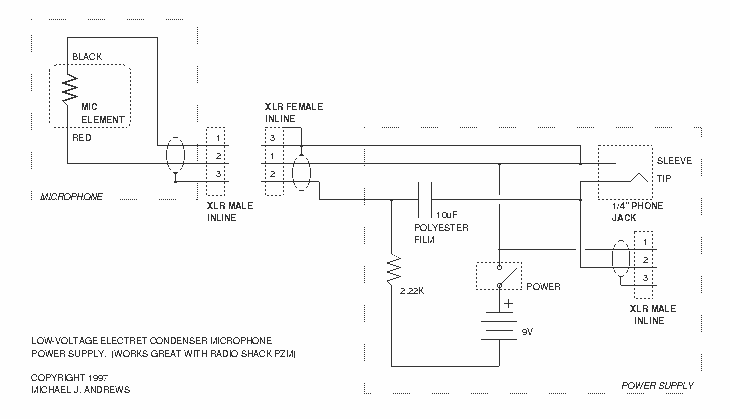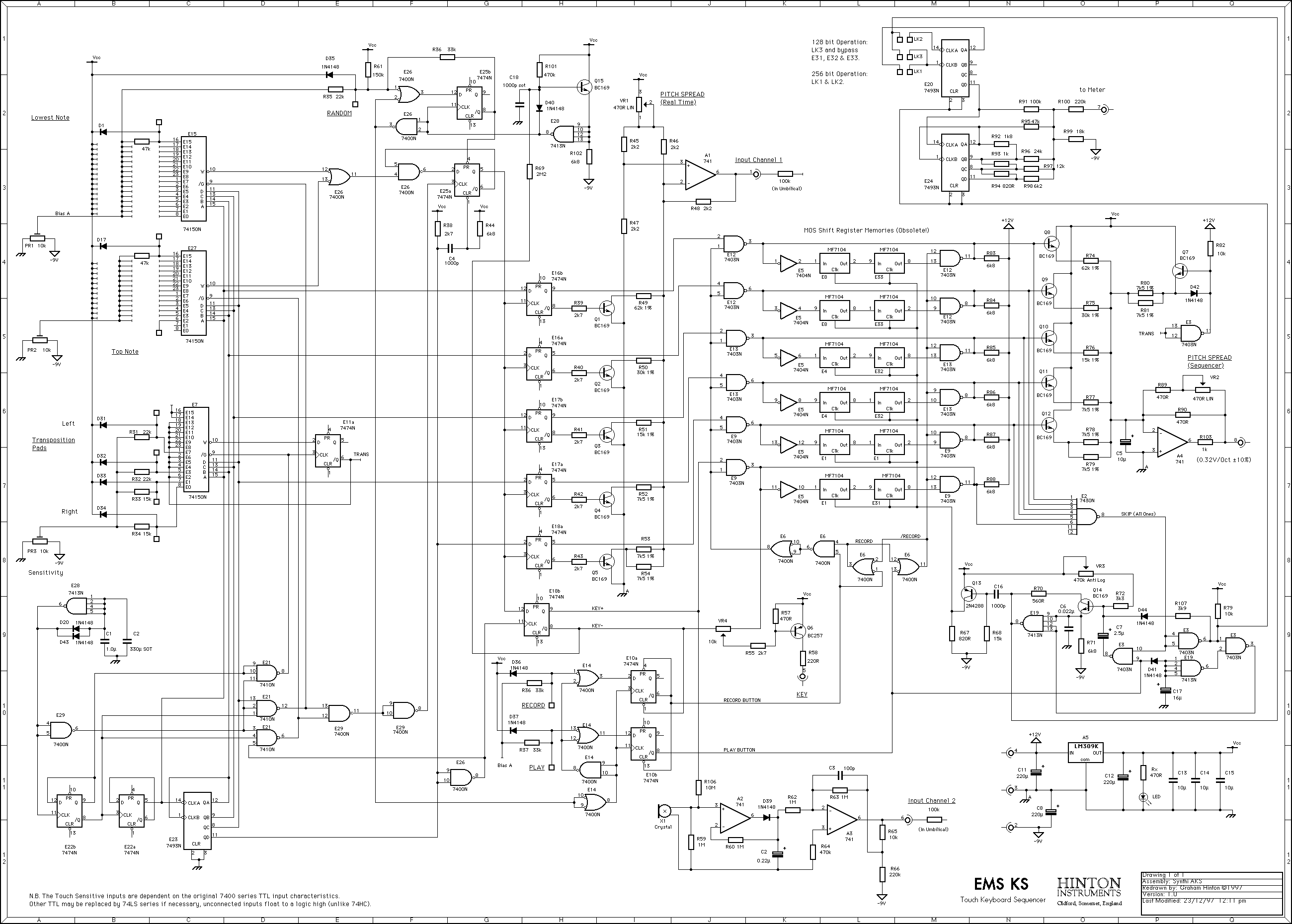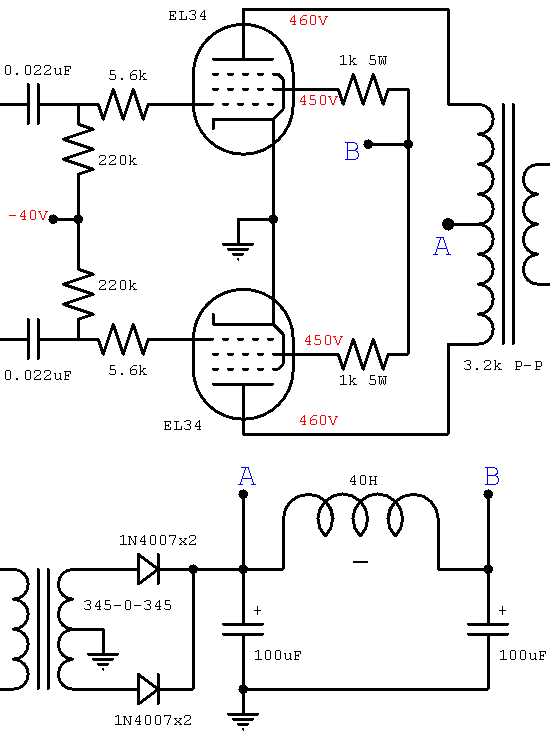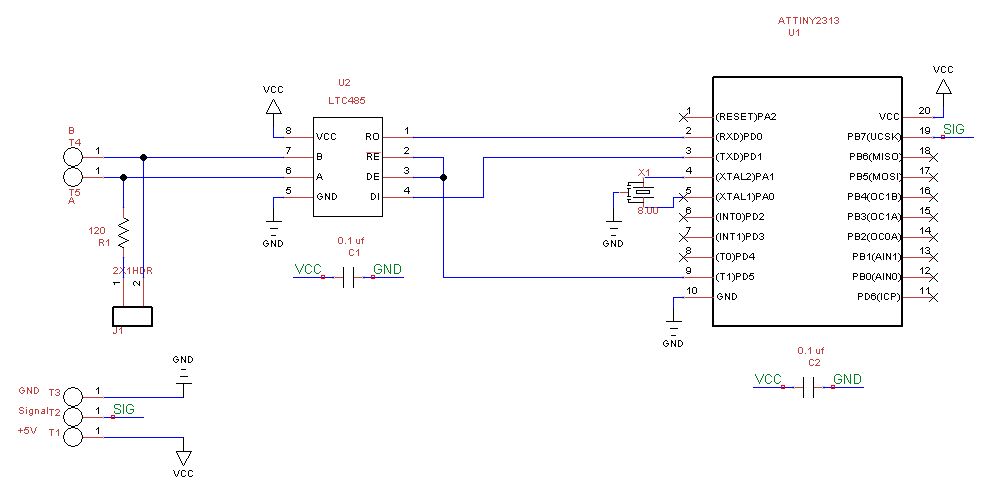
Marshall JTM-45 and 62 Bluesbreaker Reissue Modifications
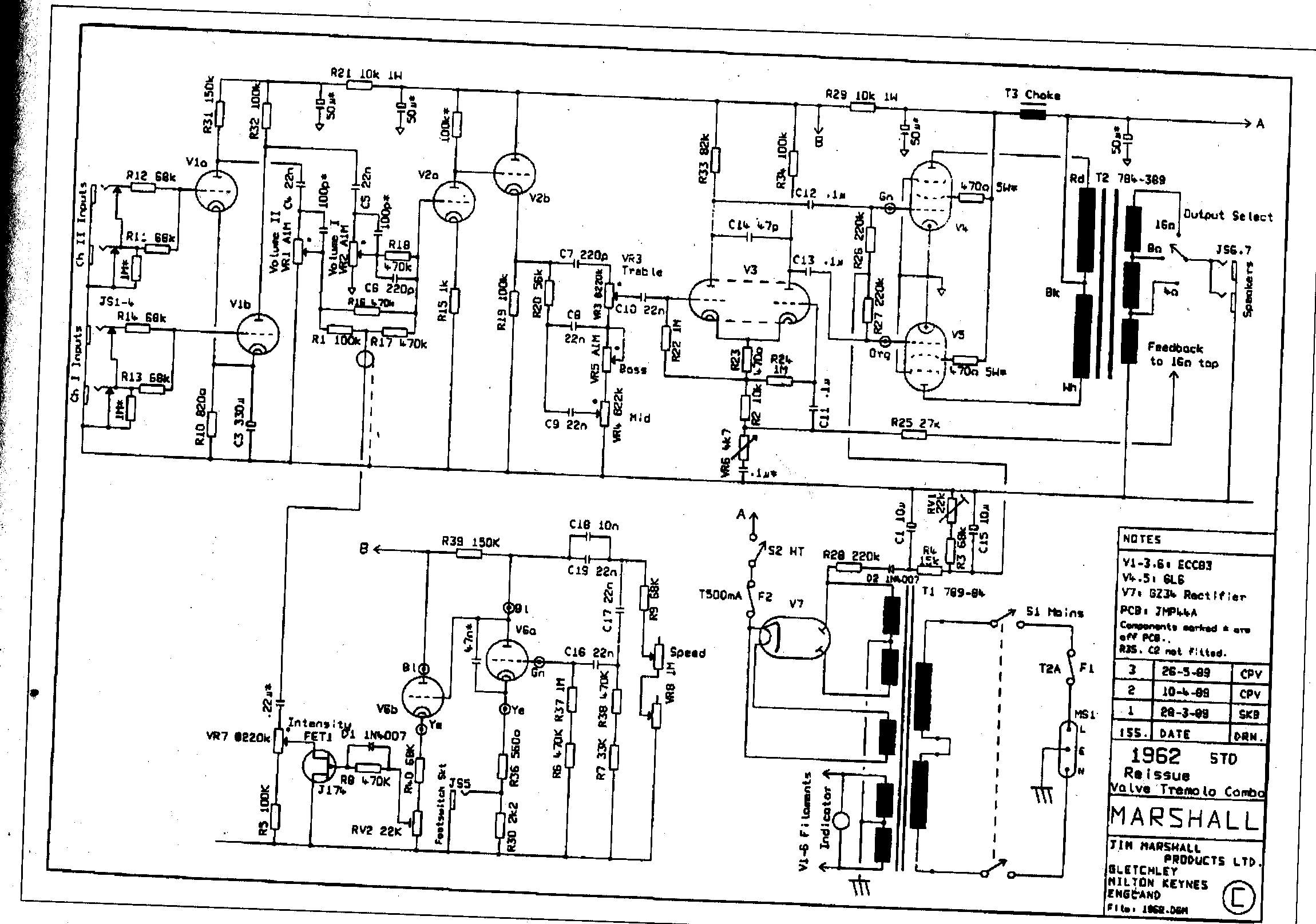
The Sovtek 5881 tubes included in these amplifiers are low-quality and produce a corresponding sound. It is advisable to replace all tubes with a Sovtek GZ34, Valve Art or GT KT66 tubes, and Ei Gold preamp tubes. The KT66 tubes should be rebias to approximately 40mA at idle. Avoid using Sovtek or "Golden Dragon" KT66 tubes, as they do not deliver the authentic KT66 sound. The filter capacitor near the GZ34 should be replaced with a 32x32µF capacitor, while the other capacitor at the opposite end of the chassis should be upgraded to a 16x16µF. These modifications will significantly enhance the amplifier's character. The 100pF bright capacitor on the Ch I volume pot can be retained or removed for a thicker, bluesier tone; earlier Bluesbreaker models included this component, while later versions did not. Upgrading the output transformer to a Mercury Magnetics or Obsolete Electronics JTM45 type is recommended, as their reproductions of the JTM45 transformers provide an authentic sound. Mercury Magnetics offers a reproduction of the Drake transformer used in '66 models and an RS transformer from early amplifiers. Obsolete Electronics produces only the RS reproduction. Both options will improve the smoothness and tonal quality of the amplifier. For repro Bluesbreaker models, a speaker upgrade is highly advisable. Celestion alnico blues speakers provide excellent sound quality, while the Weber P12B "Blue Dog" offers a similar experience at a lower price and with higher power handling. Both speaker types perform exceptionally well in an open-back cabinet, delivering the mid-60s British rock sound. After implementing these changes, the amplifier's performance will be noticeably enhanced. Lord Valve's field reports indicate that using Valve Art KT-66 tubes in the JTM-45 (both reissues and originals) can lead to issues due to parasitic oscillation that may damage the tubes. To resolve this, 5.6K swamp resistors should be placed in series with pin 5 on each power tube socket. This involves unsoldering the wire connected to pin 5, soldering the 5.6K resistor directly to the pin socket, and reconnecting the wire to the other end of the resistor, ensuring short lead lengths. Additionally, Lord Valve recommends placing 1K/5W screen resistors across pins 6 and 4, with pin 6 serving as a tie point for the screen supply. These resistors may already be present in factory JTM-45 or Bluesbreaker reissues. A loud "bang" is often heard when taking the reissues off standby, which can be mitigated by adding a 0.1µF/600V capacitor across the standby switch. It is also suggested to decrease the main filter capacitors to the original specification of 32+32µF. Power tubes in the reissues typically consist of Sovtek 5881 tubes. Re-tubing is widely regarded as the first modification to make on the reissue. KT-66 tubes are generally recommended, as they were used in the originals and provide excellent sound quality. Some users have reported success using EL34 tubes, which may not yield the most authentic JTM-45 tone but could be preferred based on individual taste. It is essential to rebias the amplifier after changing power tubes. Note that KT-66 tubes are physically large, and the Bluesbreaker Reissue may require some adjustments to accommodate them. Regarding preamp tubes (12AX7/ECC83), various configurations can be experimented with. The first preamp tube socket, located farthest from the power tubes, is crucial for tone. If an actual NOS (new old stock) tube is available, it should be placed in this socket, while the remaining sockets can be filled with Ei Gold or JJ ECC83 tubes. Ei Gold ECC83 tubes may be challenging to find and should be sourced from suppliers who perform thorough testing, as many Ei-brand preamp tubes tend to be microphonic. They are known for their bright, sparkling sound. JJ ECC83 tubes are a robust alternative, generally exhibiting lower microphonics and high quality, albeit with slightly less gain and a rounder, mellower tone.The Sovtek 5881s that come in these amps are cheap and sound like it. Change ALL tubes. Get a Sovtek GZ34, Valve Art or GT KT66s, and Ei Gold preamp tubes. Rebias the KT66s to around 40ma at idle. Do not get Sovtek or "Golden Dragon" KT66s, as these are not KT66s and don`t sound like KT66s. Change the filter cap near the GZ34 to a 32X32uF. The oth er one at the other end of the chassis should be changed to a 16X16uF. These two steps will make a big difference and change the character of the amp. The 100pF bright cap on Ch I volume pot can be kept or it can be removed if a thicker, blusier sound is sought. Earlier Bluesbreaker amps had it, later ones did not. Change the output tranny to a Mercury Magnetics or Obsolete Electronics JTM45 type. Their repro JTM45 trannies sounds spot-on. Mercury Magnetics makes a repro of the Drake tranny used in `66 models, and an RS tranny used in the early amps.
Obsolete Electronics makes the RS repro only. Either makes the amp sounds smoother and has audibly better tonal dimension. If your amp is a repro Bluesbreaker, strongly consider a speaker upgrade. Celestion alnico blues sound like a million $, but the Weber P12B "Blue Dog" is almost as nice, costs less, and handles more power. Unlike Greenbacks (old or new) both of these speakers sound fab in an open back cabinet, and give that mid-60s Brit rock sound.
Take your pick. After making these changes, when you play it, you`ll find it hard to believe it is the same amp. Lord Valve`s field reports indicate that using the Valve Arts (Chinese) KT-66 tubes in the JTM-45 (reissues and originals) can be problematic. The amp design is prone to parasitic oscillation that may kill your tube. The solution: put 5. 6K swamp resistors in series with pin 5 on each power tube socket. First unsolder the wire connected to pin 5, then solder the 5. 6K resistor directly to the pin socket. Re-connect the wire to the other end of the resistor. The goal is to make the leads on the resistor as short as possible. Lord Valve also suggests putting 1K/5W screen resistors across pins 6 and 4. Here pin 6 is used as a tie point for the screen supply. These may already be present on a factory JTM-45 or Bluesbreaker reissue. When taking the reissues off standby, a loud "bang" is often heard. This can be remedied by putting a 0. 1uF/600V capacitor across the standby switch. Decreasing the main filter capacitors to the "original" value of 32+32uF is also suggested. Power Tubes. The reissues come stock with Sovtek 5881 power tubes. Virtually everyone agrees that re-tubing is the first modification you should make to the reissue. Generally, the KT-66 tubes are recommended-the originals used these and they sound great. Others have reported success using EL34 tubes. EL34 won`t give the most "authentic" (i. e. original) JTM-45 tone, but it may be a preferable sound depending on taste. Remember, you always have to rebias after changing the power tubes. Also note that KT-66 are very large tubes (physically), and the Bluesbreaker Reissue may require some creativity to accommodate these large tubes.
Preamp Tubes (12ax7/ecc83). Note you can play around with different preamp tube configurations. The "first" preamp tube socket (the one farthest from the power tubes) is the most important tone-wise. For example, if you happen to have an actual NOS (new old stock) tube laying around, you might want to put it in the first preamp tube socket, and fill the rest with Ei Gold or possibly JJ ECC83 tubes.
Ei Gold ECC83. These may be hard to find. Check to see what kind of testing your tube supplier does for preamp tubes, as many Ei-brand preamp tubes have a tendancy to be microphonic. They have a sparkly, brilliant sound. JJ ECC83. These are the next-best preamp tubes, and are generally more robust. That is, they are typically less microphonic, and often of very high quality. They tend to have a little less gain and a more round, mellow 🔗 External reference
Obsolete Electronics makes the RS repro only. Either makes the amp sounds smoother and has audibly better tonal dimension. If your amp is a repro Bluesbreaker, strongly consider a speaker upgrade. Celestion alnico blues sound like a million $, but the Weber P12B "Blue Dog" is almost as nice, costs less, and handles more power. Unlike Greenbacks (old or new) both of these speakers sound fab in an open back cabinet, and give that mid-60s Brit rock sound.
Take your pick. After making these changes, when you play it, you`ll find it hard to believe it is the same amp. Lord Valve`s field reports indicate that using the Valve Arts (Chinese) KT-66 tubes in the JTM-45 (reissues and originals) can be problematic. The amp design is prone to parasitic oscillation that may kill your tube. The solution: put 5. 6K swamp resistors in series with pin 5 on each power tube socket. First unsolder the wire connected to pin 5, then solder the 5. 6K resistor directly to the pin socket. Re-connect the wire to the other end of the resistor. The goal is to make the leads on the resistor as short as possible. Lord Valve also suggests putting 1K/5W screen resistors across pins 6 and 4. Here pin 6 is used as a tie point for the screen supply. These may already be present on a factory JTM-45 or Bluesbreaker reissue. When taking the reissues off standby, a loud "bang" is often heard. This can be remedied by putting a 0. 1uF/600V capacitor across the standby switch. Decreasing the main filter capacitors to the "original" value of 32+32uF is also suggested. Power Tubes. The reissues come stock with Sovtek 5881 power tubes. Virtually everyone agrees that re-tubing is the first modification you should make to the reissue. Generally, the KT-66 tubes are recommended-the originals used these and they sound great. Others have reported success using EL34 tubes. EL34 won`t give the most "authentic" (i. e. original) JTM-45 tone, but it may be a preferable sound depending on taste. Remember, you always have to rebias after changing the power tubes. Also note that KT-66 are very large tubes (physically), and the Bluesbreaker Reissue may require some creativity to accommodate these large tubes.
Preamp Tubes (12ax7/ecc83). Note you can play around with different preamp tube configurations. The "first" preamp tube socket (the one farthest from the power tubes) is the most important tone-wise. For example, if you happen to have an actual NOS (new old stock) tube laying around, you might want to put it in the first preamp tube socket, and fill the rest with Ei Gold or possibly JJ ECC83 tubes.
Ei Gold ECC83. These may be hard to find. Check to see what kind of testing your tube supplier does for preamp tubes, as many Ei-brand preamp tubes have a tendancy to be microphonic. They have a sparkly, brilliant sound. JJ ECC83. These are the next-best preamp tubes, and are generally more robust. That is, they are typically less microphonic, and often of very high quality. They tend to have a little less gain and a more round, mellow 🔗 External reference
